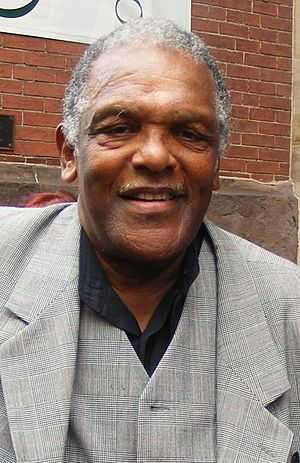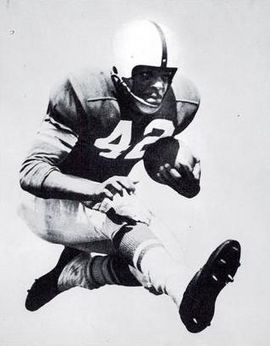Lenny Moore facts for kids

Moore in 2011
|
|||||||||||||
| No. 24 | |||||||||||||
|---|---|---|---|---|---|---|---|---|---|---|---|---|---|
| Position: | Halfback Flanker |
||||||||||||
| Personal information | |||||||||||||
| Born: | November 25, 1933 Reading, Pennsylvania, U.S. |
||||||||||||
| Height: | 6 ft 1 in (1.85 m) | ||||||||||||
| Weight: | 191 lb (87 kg) | ||||||||||||
| Career information | |||||||||||||
| High school: | Reading Senior | ||||||||||||
| College: | Penn State (1952–1955) | ||||||||||||
| NFL Draft: | 1956 / Round: 1 / Pick: 9 | ||||||||||||
| Career history | |||||||||||||
|
|||||||||||||
| Career highlights and awards | |||||||||||||
|
|||||||||||||
| Career NFL statistics | |||||||||||||
|
|||||||||||||
| Player stats at PFR | |||||||||||||
|
Pro Football Hall of Fame
|
|||||||||||||
Leonard Edward Moore (born November 25, 1933) is a famous American football player. He played for the Baltimore Colts in the National Football League (NFL) from 1956 to 1967. Moore was a very versatile player, skilled as both a halfback (a running position) and a flanker (a catching position).
Moore was so good that he was named the NFL's best new player, or Rookie of the Year, in 1956. He was chosen for the Pro Bowl, the NFL's all-star game, seven times. Because of his amazing career, he was welcomed into the Pro Football Hall of Fame in 1975, one of the highest honors a player can receive.
Contents
Early Life and Nicknames
Lenny Moore was born in Reading, Pennsylvania. From a young age, it was clear he was a special athlete. He attended Reading Senior High School, where his incredible speed on the football field earned him many nicknames.
People called him "The Reading Rocket" and "The Reading Rambler" because of how fast he ran. He was also known as "Lightning Lenny." Another nickname was "Spats," which came from the unique way he taped his high-top football shoes. The tape made them look like low-top shoes, which was unusual at the time.
College Football Career
Moore's amazing speed and talent earned him a football scholarship to Pennsylvania State University. He was the first person in his family to go to college. He played for the Nittany Lions for three seasons and was a star player.
In just 27 games, he scored an incredible 24 touchdowns. By the time he left Penn State, he held school records for the most rushing yards (2,380) and the most all-purpose yards (yards from running, catching, and returning kicks). His success in college got the attention of professional teams.
Professional NFL Career
In the 1956 NFL draft, the Baltimore Colts chose Lenny Moore as the ninth overall pick. He quickly proved to be a valuable player for the team.
A Dual-Threat Star
Moore was a special kind of player because he was great at both running the ball and catching it. He played alongside the legendary quarterback Johnny Unitas. This made the Colts' offense very hard for other teams to stop. In his first year, 1956, he won the NFL Rookie of the Year award.
In 1958 and 1959, Moore helped the Colts win back-to-back NFL championships. During the 1958 season, he had an amazing year catching the ball, with 50 catches for 938 yards and seven touchdowns.
Overcoming a Serious Injury
In 1962, Moore suffered a serious knee injury during a preseason game. He was running with the ball when he was tackled and his knee hit a metal spike used for the baseball field's first base. The spike cracked his kneecap. This injury was so bad that he had to wear a cast and missed half of the season.
Despite this setback, Moore showed his toughness. In 1964, he had one of the best seasons of his career. He scored 20 touchdowns, more than anyone else in the league. For his incredible performance after his injury, he was named the Comeback Player of the Year and the Most Valuable Player (MVP).
An Unbreakable Record
From 1963 to 1965, Moore scored a touchdown in 17 straight games that he played in. This set an NFL record that stood for 40 years. It showed just how consistent and talented he was.
Facing Challenges as a Black Player
During the 1950s and 1960s, being an African American player in the NFL was not easy. Moore and other black players faced unfair treatment because of their race.
Moore said that on the football field, his team was like a family. They all worked together. But off the field, things were different. Because of segregation laws at the time, black and white players often could not eat at the same restaurants or stay in the same hotels when they traveled for games.
Despite these challenges, Moore focused on being the best player he could be. He became a role model and an inspiration for many people.
Legacy and Life After Football
Moore retired from football after the 1967 season. In his 12-year career, he scored 111 touchdowns and gained over 11,000 yards. The Colts retired his jersey number, 24, which means no other Colts player will ever wear it.
He has received many honors. He was named to the Pro Football Hall of Fame, the NFL's 1950s All-Decade Team, and the NFL's 100th Anniversary All-Time Team. Many experts still consider him one of the greatest football players ever. He is the only player in NFL history with at least 40 rushing touchdowns and 40 receiving touchdowns.
After his football career, Moore worked for the Maryland Department of Juvenile Services for 26 years. He traveled to schools to talk to students, sharing his life experiences to help them make good choices. He also does charity work, raising money to fight scleroderma, a disease that his son passed away from.
NFL career statistics
| Legend | |
|---|---|
| NEA NFL MVP | |
| Won NFL Championship | |
| Led the league | |
| Bold | Career high |
| Year | Team | Games | Rushing | Receiving | Fumbles | |||||||||||
|---|---|---|---|---|---|---|---|---|---|---|---|---|---|---|---|---|
| GP | GS | Att | Yds | Avg | Y/G | Lng | TD | Rec | Yds | Avg | Lng | TD | Fum | FR | ||
| 1956 | BAL | 12 | 12 | 86 | 649 | 7.5 | 54.1 | 79 | 8 | 11 | 102 | 9.3 | 27 | 1 | 5 | 1 |
| 1957 | BAL | 12 | 12 | 98 | 488 | 5.0 | 40.7 | 55 | 3 | 40 | 687 | 17.2 | 82 | 7 | 6 | 2 |
| 1958 | BAL | 12 | 12 | 82 | 598 | 7.3 | 49.8 | 73 | 7 | 50 | 938 | 18.8 | 77 | 7 | 5 | 2 |
| 1959 | BAL | 12 | 12 | 92 | 422 | 4.6 | 35.2 | 31 | 2 | 47 | 846 | 18.0 | 71 | 6 | 4 | 1 |
| 1960 | BAL | 12 | 12 | 91 | 374 | 4.1 | 31.2 | 57 | 4 | 45 | 936 | 20.8 | 80 | 9 | 3 | 1 |
| 1961 | BAL | 13 | 13 | 92 | 648 | 7.0 | 49.8 | 54 | 7 | 49 | 728 | 14.9 | 72 | 8 | 1 | 0 |
| 1962 | BAL | 10 | 7 | 106 | 470 | 4.4 | 47.0 | 25 | 2 | 18 | 215 | 11.9 | 80 | 2 | 1 | 1 |
| 1963 | BAL | 7 | 6 | 27 | 136 | 5.0 | 19.4 | 25 | 2 | 21 | 288 | 13.7 | 34 | 2 | 2 | 0 |
| 1964 | BAL | 14 | 12 | 157 | 584 | 3.7 | 41.7 | 32 | 16 | 21 | 472 | 22.5 | 74 | 3 | 8 | 4 |
| 1965 | BAL | 12 | 12 | 133 | 464 | 3.5 | 38.7 | 28 | 5 | 27 | 414 | 15.3 | 52 | 3 | 3 | 2 |
| 1966 | BAL | 13 | 8 | 63 | 209 | 3.3 | 16.1 | 18 | 3 | 21 | 260 | 12.4 | 36 | 0 | 2 | 0 |
| 1967 | BAL | 14 | 0 | 42 | 132 | 3.1 | 9.4 | 21 | 4 | 13 | 153 | 11.8 | 37 | 0 | 1 | 1 |
| Career | 143 | 118 | 1,069 | 5,174 | 4.8 | 36.2 | 79 | 63 | 363 | 6,039 | 16.6 | 82 | 48 | 41 | 15 | |


